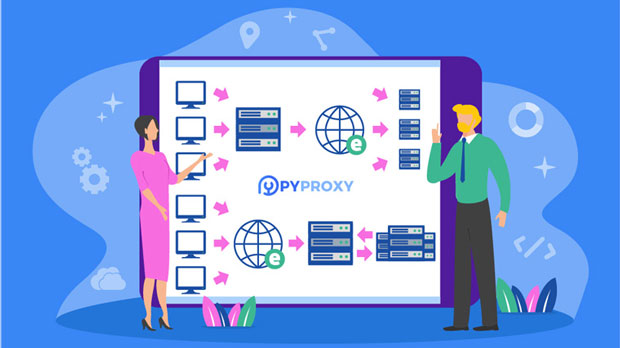Is it more beneficial to choose an HTTP proxy or a SOCKS5 proxy in an enterprise network?
In the ever-evolving landscape of enterprise networking, choosing the right proxy protocol is crucial for ensuring both security and performance. Two of the most common types of proxies used in enterprise environments are HTTP proxies and socks5 proxies. Both protocols have their strengths and weaknesses, which make them suitable for different scenarios. HTTP proxies are generally more efficient for web traffic and are easier to configure, making them ideal for tasks such as content filtering and caching. On the other hand, SOCKS5 proxies offer more versatility by supporting a wider range of protocols, including FTP and P2P applications, but require more complex configuration. This article explores the key differences between HTTP and SOCKS5 proxies, analyzing the benefits and limitations of each to help enterprises make an informed decision based on their specific needs. Understanding HTTP Proxy: Strengths and Use CasesHTTP proxies operate at the application layer of the OSI model, focusing solely on handling HTTP and HTTPS traffic. They are widely used in enterprise networks for a variety of reasons, including security, performance, and ease of use.1. Performance and Speed One of the primary benefits of HTTP proxies is their efficiency when handling web-based traffic. Because HTTP is the protocol used by web browsers, an HTTP proxy is optimized for this type of traffic, resulting in faster response times and lower latency for web-related tasks. HTTP proxies can also cache web content, which further improves performance by reducing the need to fetch the same resources from the internet repeatedly.2. Simplicity and Ease of Setup Setting up an HTTP proxy is relatively straightforward. Since HTTP proxies only handle HTTP and HTTPS traffic, the configuration process tends to be simpler compared to SOCKS5 proxies. In addition, most corporate networks already use web-based applications, so integrating an HTTP proxy into existing infrastructure is typically less complex.3. Content Filtering and Access Control HTTP proxies are commonly employed in enterprise networks for content filtering and access control. By intercepting and analyzing HTTP traffic, businesses can block access to certain websites, monitor browsing behavior, and enforce corporate policies. For example, businesses may want to prevent employees from accessing non-work-related sites during office hours or restrict access to potentially harmful content.4. Security Concerns While HTTP proxies offer a certain level of security by acting as an intermediary between the client and the server, they are generally less secure than SOCKS5 proxies when it comes to handling encrypted traffic. This is because HTTP proxies do not inherently support SSL/TLS tunneling, which means that sensitive data transmitted over HTTPS may be vulnerable to interception if the proxy is not properly configured. However, many modern HTTP proxies do support HTTPS interception, adding an extra layer of security. socks5 proxy: Versatility and Advanced FeaturesSOCKS5 proxies, unlike HTTP proxies, operate at the transport layer and are capable of handling a wide variety of traffic types, including HTTP, FTP, SMTP, and even peer-to-peer (P2P) protocols. This versatility makes SOCKS5 proxies more flexible and suited for scenarios where a broader range of network traffic needs to be handled.1. Protocol Agnostic One of the major advantages of SOCKS5 proxies is their ability to work with virtually any type of internet traffic, including applications that use FTP, SMTP, or even non-HTTP-based protocols. This makes them ideal for businesses that rely on a diverse range of applications and services. For instance, if an organization needs to route non-web traffic through a proxy, such as FTP or torrent data, a SOCKS5 proxy would be the optimal choice.2. Better Security and Privacy SOCKS5 proxies offer a higher level of security than HTTP proxies, as they support both TCP and UDP traffic and are better equipped to handle encrypted traffic. With SOCKS5, data transmission is more secure, especially when used in conjunction with SSL/TLS encryption. Furthermore, SOCKS5 proxies do not alter or inspect the content of packets, which enhances privacy and makes it harder for external entities to intercept or manipulate the traffic.3. Bypassing Geo-Restrictions and Firewalls Another important feature of SOCKS5 proxies is their ability to bypass geographic restrictions and firewalls. Since SOCKS5 proxies are transparent and work at a lower level in the network stack, they are often more successful in circumventing government censorship or restrictive network firewalls compared to HTTP proxies. This can be particularly useful for multinational companies operating in regions with strict internet access regulations.4. Complexity and Setup Challenges While SOCKS5 proxies offer advanced capabilities, they come with a downside: they are generally more difficult to configure than HTTP proxies. Setting up a SOCKS5 proxy requires a deeper understanding of network protocols, and troubleshooting issues can be more complex. Additionally, because SOCKS5 proxies support a wider range of applications and protocols, their configuration options may be overwhelming for administrators who are not familiar with networking.Comparing HTTP Proxy and SOCKS5 Proxy: Which One Is Better for Enterprises?When choosing between an HTTP proxy and a SOCKS5 proxy for an enterprise network, businesses must consider several factors, such as network requirements, security needs, and the types of traffic they handle.1. Web Traffic vs. Diverse Protocols For enterprises primarily focused on managing web traffic (HTTP/HTTPS), an HTTP proxy is generally sufficient. It offers a straightforward solution for controlling access to websites, monitoring employee browsing, and improving web performance through caching. On the other hand, if the enterprise needs to manage a variety of network protocols, such as FTP, P2P, or email, a SOCKS5 proxy would be more appropriate due to its support for a broader range of applications.2. Security Needs In terms of security, SOCKS5 proxies have the upper hand. They are better at protecting sensitive data and offer more robust encryption options. HTTP proxies, while sufficient for basic security needs, are generally more vulnerable when dealing with encrypted HTTPS traffic unless configured with SSL/TLS support.3. Performance Considerations From a performance perspective, HTTP proxies tend to excel in environments where web traffic is the primary concern. Their ability to cache content and reduce server load makes them ideal for enterprises that rely heavily on web-based applications. However, SOCKS5 proxies may be slower when handling large volumes of diverse traffic due to their added flexibility and support for multiple protocols.4. Ease of Configuration For ease of deployment, HTTP proxies are typically the better choice. Their simpler configuration process makes them more suitable for enterprises with limited IT resources. Conversely, SOCKS5 proxies require more advanced networking knowledge and may require additional resources for proper setup and maintenance.Conclusion: Making the Right Choice for Your Enterprise NetworkThe decision between an HTTP proxy and a SOCKS5 proxy largely depends on the specific needs and goals of the enterprise. For businesses focused on web traffic management, content filtering, and performance optimization, an HTTP proxy is often the most suitable option. However, for companies with more complex requirements—such as the need to support diverse applications and ensure high levels of security—SOCKS5 proxies may be the better choice.Ultimately, the right proxy solution will depend on the network infrastructure, the types of applications in use, and the level of security required. Regardless of the choice, it is crucial for enterprises to thoroughly assess their needs and select the proxy protocol that aligns with their business goals, security policies, and operational workflows.
2025-01-03
























































